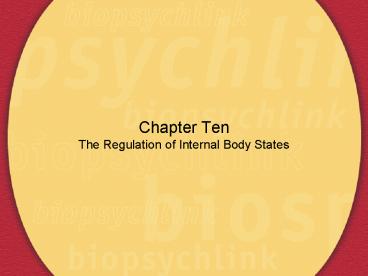Chapter Ten The Regulation of Internal Body States - PowerPoint PPT Presentation
1 / 19
Title:
Chapter Ten The Regulation of Internal Body States
Description:
Glucose, Insulin, and Glucagon. Glucose-primary energy source for cells, especially neurons ... Glucagon-stimulates liver to convert glycogen to glucose. Eating ... – PowerPoint PPT presentation
Number of Views:49
Avg rating:3.0/5.0
Title: Chapter Ten The Regulation of Internal Body States
1
Chapter TenThe Regulation of Internal Body States
2
Figure 10.3 Major subdivisions of the
hypothalamus and pituitary
3
Thirst and Related Processes
- When the body needs waterthirst
- Related Processes
- Vasopressin-hormone released from posterior
pituitary - constricts blood vessels
- enables kidneys to reabsorb water
4
Types of Thirst
- Osmotic Thirst
- When solutes become concentrated outside the cell
and water is extracted from inside cells - OVLT-organum vasculosum laminae terminalis
- detects osmotic pressure
- sends information to hypothalamus
- paraventricular nucleus
- supraoptic nucleus
- lateral preoptic area
5
Figure 10.6 The consequence of a difference in
osmotic pressure(a) A solute such as NaCl is
more concentrated outside the cell than inside.
(b) Water flows by osmosis out of the cell until
the concentrations are equal. Neurons in certain
brain areas detect their own dehydration and
trigger thirst.
6
Types of Thirst
- Hypovolemic Thirst
- thirst resulting from low blood volume
- Mechanisms
- Baroreceptors-attached to large veins detect
pressure of blood returning to the heart - Renin released by kidneys assists in creating
high levels of angiotensin II which constricts
blood vessels and signals brain to stimulate
thirst (subfornical organ)
7
(No Transcript)
8
Table 10.1
9
Bodily (peripheral) Influences on Hunger
- Mouth
- oral sensations
- Stomach
- Vagus nerve-transmits information on stomach
distention to the brain. - Splanchnic nerve-transmits information on
nutrient content of food being consumed to the
brain - Intestines
- duodenum-once food reaches here, CCK is released
and signals to stop eating (possibly acting in
brain)
10
Glucose, Insulin, and Glucagon
- Glucose-primary energy source for cells,
especially neurons - Glycogen-short term energy stored in liver
- Insulin-assists glucose utilization and storage
- Glucagon-stimulates liver to convert glycogen to
glucose
11
(No Transcript)
12
Eating and the Hypothalamus
13
The Hypothalamus and Eating Regulation
- Lateral Hypothalamus
- Damage to this area animal refuses food and may
starve itself to death - Axons extend to the medulla possibly altering
taste sensations - Activates a circuit that excites dopamine cells
initiating reinforcement of behaviors - Sends axons to spinal cord controlling autonomic
responses such as digestive secretions
14
The Hypothalamus and Eating Regulation
- Paraventricular Nucleus
- Damage here eating larger than normal meals
resulting in weight gain - Ventromedial Hypothalamus
- Lesions to the VMH lead to finicky eating and to
overeating - The overeating is due to eating more frequently
than normal because of high insulin levels
resulting in weight gain
15
Neurotransmitters Involved in Eating
- Neurotransmitters/neurohormones
- Leptin-produced by fat cells and is involved in
satiety, acts in hypothalamus to decrease eating - Neuropeptide Y- inhibits neurons in the PVN and
causes increased in meal size - Glutamate-stimulates eating in the lateral
hypothalamus - Dopamine-inhibits feeding-related neurons in the
hypothalamus - Others Orexin, CART, MCH
- Know neurotransmitters/neurohormones that cause
eating and those that cause satiety (satiety
means to be full!)
16
Glutamate and Eating
17
Figure 10.24 Relation among weight, leptin, NPY,
and eatingOrdinarily, high levels of body fat
produce leptin, which inhibits eating. Obese
mice fail to produce leptin. Obese humans produce
leptin but fail to respond to it.
18
Eating Disorders
Obesity
Anorexia unwilling to eat, significantly
underweight occurs mostly in women during
adolescence Bulimia alternating between dieting
and overeating
19
(No Transcript)































